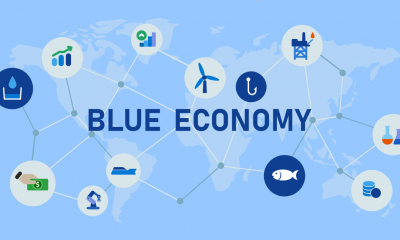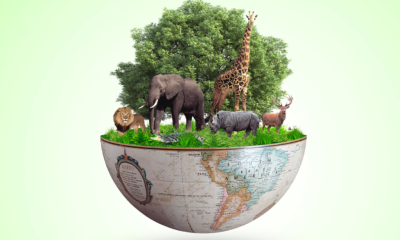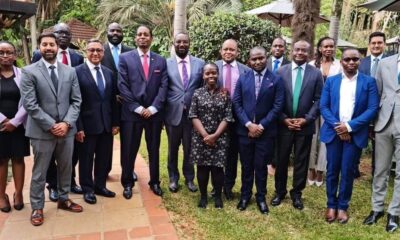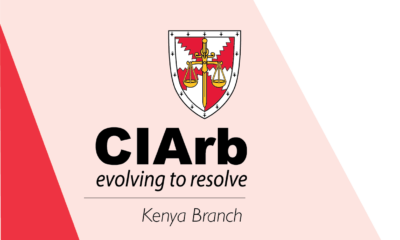News & Analysis
The Role of the Blue Economy in Fostering Sustainability
Published
2 months agoon
By
Admin
By Hon. Prof. Kariuki Muigua, OGW, PhD, C.Arb, FCIArb is a Professor of Environmental Law and Dispute Resolution at the University of Nairobi, Member of Permanent Court of Arbitration, Leading Environmental Law Scholar, Respected Sustainable Development Policy Advisor, Top Natural Resources Lawyer, Highly-Regarded Dispute Resolution Expert and Awardee of the Order of Grand Warrior (OGW) of Kenya by H.E. the President of Republic of Kenya. He is the Academic Champion of ADR 2024, the African ADR Practitioner of the Year 2022, the African Arbitrator of the Year 2022, ADR Practitioner of the Year in Kenya 2021, CIArb (Kenya) Lifetime Achievement Award 2021 and ADR Publisher of the Year 2021 and Author of the Kenya’s First ESG Book: Embracing Environmental Social and Governance (ESG) tenets for Sustainable Development” (Glenwood, Nairobi, July 2023) and Kenya’s First Two Climate Change Law Book: Combating Climate Change for Sustainability (Glenwood, Nairobi, October 2023), Achieving Climate Justice for Development (Glenwood, Nairobi, October 2023), Promoting Rule of Law for Sustainable Development (Glenwood, Nairobi, January 2024) and Actualizing the Right to a Clean and Healthy Environment (Glenwood, Nairobi, March 2024)*
Sustainability refers to creating and maintaining the conditions under which humans and nature can exist in productive harmony to support present and future generations. The need to strike a balance between the environmental, social and economic facets of development towards sustainability gave rise to the concept of Sustainable Development. The idea of Sustainable Development refers to development that meets the needs of the present without compromising the ability of future generations to meet their own needs.
The blue economy is vital in the sustainability agenda. It has been correctly observed that the idea of blue economy recognizes that the oceans, which cover approximately 71% of the Earth’s surface, possess untapped potential to unlock Sustainable Development in various sectors. It has been argued that sustainable utilization of the blue economy can unlock development through in areas such as smart shipping, ports, transportation and global connectivity; employment, job creation and poverty eradication; cities, tourism, resilient coasts and infrastructure; sustainable energy, mineral resources and innovative industries; managing and sustaining marine life, conservation and sustainable economic activities; ending hunger, securing food supplies and promoting good health and sustainable fisheries; climate action, agriculture waste management and pollution-free oceans; maritime security, safety and regulatory enforcement and people, culture, communities and societies.
It has further been observed that oceans play a key role in the economic development of nations through the exploitation of maritime and marine resources – for example, through shipping, commercial fishing, and oil, gas, and mineral development. According to the World Bank, marine and freshwater ecosystems play a significant contribution in achieving sustainability in areas such as food security, nutrition and health, tourism, climate change mitigation, provisions of homes and shelter, sustainable economic growth, and trade. For example, it has been observed that the fisheries and aquaculture sector is a vital source of livelihoods, nutritious food and economic opportunities, and has a key role to play in meeting one of the world’s greatest challenges: feeding a population set to rise to 9.6 billion people by 2050.
In addition, it has been asserted that fisheries and aquaculture play a significant role in eliminating hunger, promoting health and reducing poverty. It is estimated that fish contributes over 16 percent of the animal protein consumed by the world’s population and 6.5 percent of all protein consumed, with 1 billion people relying on this source of protein. Fish is also a particularly critical source of nutrition. In addition, the blue economy is an important source of coastal and marine tourism. It has been observed that maritime or ocean related tourism, as well as coastal tourism, are vital sectors of the economy in many countries, including Small Island Developing States (SIDs) and coastal Least Developed Countries (LDCs).
Coastal and ocean-related tourism comes in various forms and includes dive tourism, maritime archaeology, surfing, cruises, ecotourism, and recreational fishing operations. It has been argued that sustainable tourism can be part of the blue economy, promote conservation and sustainable use of marine environments and species, generate income for local communities (thus alleviating poverty), and maintain and respect local cultures, traditions, and heritage.
The blue economy also plays a key role in the transport sector. It has been observed that the blue economy is an important source of transport through maritime transport which includes passenger transport: sea, coastal and inland passenger water transport; freight transport: sea, coastal freight and inland freight water transport; and services for transport: renting and leasing water transport equipment. Further, it has been argued that inland transport is considered part of the blue economy because it includes the transportation of passengers and freight via rivers, canals, lakes and other inland waterways, including within harbours and ports. It has been also observed that shipping has for many centuries been the major form of transportation, as well as an essential communication link connecting coastal cities, countries and continents.
The blue economy is therefore vital in the transport sector. The blue economy also plays a crucial role in trade. The World Trade Organization points out that although seafood has long been traded internationally, trade has increased dramatically in recent decades such that fish and fishery products now constitute the most highly traded food commodity internationally. Further, it is estimated that 90% of globally traded goods are carried by sea. The blue economy therefore plays a key role in facilitating international trade.
In addition, the blue economy is a major source of energy. It has been observed that oceans play a key role in extraction of energy sources such as oil and gas which are vital in the global energy supply49. Further, according to the International Renewable Energy Agency (IRENA), oceans are a source of abundant renewable energy potential, capable of driving a blue economy based on sustainable use of ocean resources. IRENA points out that energy harnessed from the oceans, through offshore renewables, can contribute to the decarbonisation of the power sector and to other end-use applications that are relevant for a blue economy (for example, shipping, cooling and water desalination).
Further, it has been contended that the blue economy has made it possible to tap into emerging ocean energy technologies – including wave, tidal, ocean thermal energy conversion and salinity gradient energy which have the potential to unlock clean and sustainable energy and economic development. In addition, it has been pointed out that renewable energies in the blue economy also contribute to wealth and jobs creation, in addition to the diversification, development and growth of local economies, especially in coastal areas and in developing countries.
The blue economy is also vital in climate change mitigation. It has been pointed out that coral reefs, mangroves, seagrass meadows and wetlands deliver critical ecosystem services such as coastal protection and carbon sequestration. Oceans constitute a major sink for anthropogenic emissions, absorbing nearly 25 percent of the extra carbon dioxide added to Earth’s atmosphere by burning fossil fuels. Further, it has been pointed out that blue carbon’ sinks like mangrove forests, sea grass beds and other vegetated ocean habitats are up to five times as effective as tropical forests at sequestering carbon.
It has been argued that ocean-based mitigation has the potential to reduce emissions by more than 11 billion tonnes of greenhouse gasses per annum in 2050, which could close the global emissions gap by up to 25 per cent. It is therefore necessary to tap into the blue economy in order to enhance the global response to climate change. From the foregoing, it is evident that the blue economy plays a key role in Sustainable Development. It has been argued that a healthy blue economy is key for a sustainable future both for people and the planet. It has been pointed out that the world’s oceans – their temperature, chemistry, currents and life – drive global systems that make the Earth habitable for humankind.
The blue economy offers the possibilities of improved efficiency in our land and ocean management, better treatment and governance of marine ecosystems, a more equitable model of global health standards, lower emissions and resilience against climate change. It has further been asserted that the blue economy in Africa provides numerous advantages such as habitat for fish and marine life; carbon sequestration; shoreline protection; waste recycling and storing; ocean processes that influence climate and biodiversity and new emerging activities such as desalination; marine biotechnologies, ocean energy and seabed mining.
Fostering the blue economy is thus vital in order to achieve sustainability. The role of the blue economy in sustainability is recognized under the United Nation’s 2030 Agenda for Sustainable Development. SDG 14 seeks to conserve and sustainably use the oceans, seas and marine resources for Sustainable Development.
SDG 14 seeks to foster the blue economy through targets such as preventing and significantly reducing marine pollution of all kinds, in particular from land-based activities, including marine debris and nutrient pollution; sustainably managing and protecting marine and coastal ecosystems to avoid significant adverse impacts, including by strengthening their resilience, and taking action for their restoration in order to achieve healthy and productive oceans; minimizing and addressing the impacts of ocean acidification, including through enhanced scientific cooperation at all levels; regulating harvesting and end overfishing, illegal, unreported and unregulated fishing and destructive fishing practices and implementing science-based management plans, in order to restore fish stocks; and increasing scientific knowledge, developing research capacity and transfer of marine technology.
Realizing the targets under SDG 14 is necessary in fostering the blue economy for sustainability. At a continental level, Africa Union’s Agenda 2063 recognizes the potential of the blue economy to trigger Sustainable Development in Africa through marine resources, fishing, tourism, energy, port operations, mining and marine transport. Agenda 2063 calls for the sustainable utilization and management of the Blue Economy in Africa in order to realize its potential.
In addition, the Africa Blue Economy Strategy seeks to achieve an inclusive and sustainable blue economy that significantly contributes to Africa’s transformation and growth. It aims to guide the development of an inclusive and sustainable blue economy that becomes a significant contributor to Africa’s transformation and growth, through advancing knowledge on marine and aquatic biotechnology, environmental sustainability, the growth of an Africa-wide shipping industry, the development of sea, river and lake transport, the management of fishing activities on these aquatic spaces, and the exploitation and beneficiation of deep sea mineral and other resources.
The strategy outlines the key drivers of change that are shaping Africa blue economy development; strategic and technical challenges to blue economy development and identifies priority areas of intervention for sustainable blue economy development in Africa. This strategy is therefore key in fostering the blue economy for sustainability in Africa.
*This is an extract from Kenya’s First Clean and Healthy Environment Book: Actualizing the Right to a Clean and Healthy Environment (Glenwood, Nairobi, January 2024) by Hon. Prof. Kariuki Muigua, OGW, PhD, Professor of Environmental Law and Dispute Resolution, Senior Advocate of Kenya, Chartered Arbitrator, Kenya’s ADR Practitioner of the Year 2021 (Nairobi Legal Awards), ADR Lifetime Achievement Award 2021 (CIArb Kenya), African Arbitrator of the Year 2022, Africa ADR Practitioner of the Year 2022, Member of National Environment Tribunal (NET) Emeritus (2017 to 2023) and Member of Permanent Court of Arbitration nominated by Republic of Kenya and Academic Champion of ADR 2024. Prof. Kariuki Muigua is a foremost Environmental Law and Natural Resources Lawyer and Scholar, Sustainable Development Advocate and Conflict Management Expert in Kenya. Prof. Kariuki Muigua teaches Environmental Law and Dispute resolution at the University of Nairobi School of Law, The Center for Advanced Studies in Environmental Law and Policy (CASELAP) and Wangari Maathai Institute for Peace and Environmental Studies. He has published numerous books and articles on Environmental Law, Environmental Justice Conflict Management, Alternative Dispute Resolution and Sustainable Development. Prof. Muigua is also a Chartered Arbitrator, an Accredited Mediator, the Managing Partner of Kariuki Muigua & Co. Advocates and Africa Trustee Emeritus of the Chartered Institute of Arbitrators 2019-2022. Prof. Muigua is a 2023 recipient of President of the Republic of Kenya Order of Grand Warrior (OGW) Award for his service to the Nation as a Distinguished Expert, Academic and Scholar in Dispute Resolution and recognized among the top 5 leading lawyers and dispute resolution experts in Band 1 in Kenya by the Chambers Global Guide 2024 and was listed in the Inaugural THE LAWYER AFRICA Litigation Hall of Fame 2023 as one of the Top 50 Most Distinguished Litigation Lawyers in Kenya and the Top Arbitrator in Kenya in 2023.
References
Africa Union., ‘Africa Blue Economy Strategy.’ Available at https://www.auibar.org/sites/default/files/202010/sd_20200313_africa_blue_econ omy_strategy_en.pdf (Accessed on 04/03/2024).
Africa Union., ‘Agenda 2063: The Africa we Want.’ Available at https://au.int/sites/default/files/documents/33126-docframework_document_book.pdf (Accessed on 04/03/2024).
Bove. T., ‘What are the Promises of a Blue Economy?’ Available at https://earth.org/blue-economy/# (Accessed on 04/03/2024).
Commonwealth Blue Economy., ‘Sustainable Blue Economy’ Available at https://thecommonwealth.org/bluecharter/sustainable-blueeconomy#:~:text=The%20blue%20economy %20embraces%20economic,of%20povert y%20and%20climate%20change (Accessed on 04/03/2024).
Convention on Biological Diversity., ‘The Blue Economy is Critical to Food Security and the Fight Against Poverty’ Available at https://www.cbd.int/article/waterforbiodiversity-2 (Accessed on 04/03/2024).
East African Community., ‘Blue Economy’ Available at https://www.eac.int/environment/aquatic-ecosystems/blueeconomy#:~:text=The%20Blue%20Economy%20describes%20the,%2C%20lakes%2C%20ri vers%20and%20groundwater (Accessed on 04/03/2024).
European Commission., ‘Maritime Transport’ Available at https://blue-economyobservatory.ec.europa.eu/eu-blue-economy-sectors/maritimetransport_en#:~:text=Inland%20 transport%20is%20considered%20part,including%2 0within%20harbours%20and%20ports. (Accessed on 04/03/2024).
European Commission., ‘Sustainable Blue Economy’ Available at https://oceansand-fisheries.ec.europa.eu/ocean/blue-economy/sustainable-blue-economy_en (Accessed on 04/03/2024).
Fitzmaurice. M., ‘The Principle of Sustainable Development in International Development Law.’ International Sustainable Development Law., Vol 1.
Food and Agriculture Organization., ‘Introduction’ Available at https://www.fao.org/3/X2250E/x2250e06.htm (Accessed on 05/03/2024).
Giovannoni. E., & Fabietti. G., ‘What Is Sustainability? A Review of the Concept and Its Applications.’ In: Busco, C., Frigo, M., Riccaboni, A., Quattrone, P. (eds) Integrated Reporting. Springer, Cham. Available at https://doi.org/10.1007/978-3-319-02168- 3_2 (Accessed on 04/03/2024).
International Institute for Environment and Development., ‘Climate change and the Blue Economy: A Sustainable and Equitable Blue Economy Can Support Climate Action’ Available at https://www.iied.org/sites/default/files/pdfs/2023- 11/22171g.pdf (Accessed on 04/03/2024).
International Renewable Energy Agency., ‘Fostering a Blue Economy: Offshore Renewable Energy’ Available at https://www.irena.org/- /media/Files/IRENA/Agency/Publication/2020/Dec/IRENA_ Fostering_Blue_Eco nomy_2020.pdf (Accessed on 04/03/2024).
Kenya Maritime Authority., ‘Report on the Global Sustainable Blue Economy Conference 26th-28th November 2018 Nairobi, Kenya.’ Available at http://kenyaforimo.kma.go.ke/wpcontent/uploads/2019/11/SBEC-FINALREPORT-8-DECEMBER-2018-rev-2-1-2-PDF2-3-compressed.pdf (Accessed on 04/03/2024).
Manso. J., et al., ‘Renewable Energies and Blue Economy: New Trends in Global Research’ Energies, Volume 16,No. 10 (2023).
Maritime Sector., Available at https://www.windrosenetwork.com/MaritimeSector (Accessed on 04/03/2024).
Muigua. K., ‘Fostering Africa’s Blue Economy: Problems and Promises’ Available at https://kmco.co.ke/wp-content/uploads/2023/07/Fostering-Africas-BlueEconomy-Problems-and-Promises-.pdf (Accessed on 05/03/2024).
Purcell. N., ‘What is the Blue Economy?’ Available at https://bluerobotics.com/what-is-theblueeconomy/#:~:text=The%20blue%20economy%20encourages%20the,reduce%20f uel%20consumption%20 and%20emissions. (Accessed on 04/03/2024).
Purcell. N., ‘What is the Blue Economy?’ Available at https://bluerobotics.com/what-is-theblueeconomy/#:~:text=The%20blue%20economy%20encourages%20the,reduce%20f uel%20consumption%20 and%20emissions (Accessed on 04/03/2024).
United Nations Development Programme., ‘Goal 14: Life Below Water.’ Available at https://www.undp.org/sustainable-developmentgoals/belowwater?gclid=Cj0KCQjwzdOlBhC NARIsAPMwjbyodp8PZIkguJb9OPW9 JCjZ2fPWPOOvlgrRnGolWtE86-55pcSV5saAqJCEALw_wcB (Accessed on 04/03/2024).
United Nations Development Programme., ‘Leveraging the Blue Economy for Inclusive and Sustainable Growth.’ Policy Brief, Issue No 6/2018., Available at https://www.undp.org/sites/g/files/zskgke326/files/migration/ke/Policy-Brief- -2018—6— Blue-Economy-for-Inclusive-and-Sustainable-Growth.pdf (Accessed on 04/03/2024).
United Nations Environment Programme., ‘Enabling Sustainable, Resilient and Inclusive Blue Economies.’ Available at https://www.unep.org/exploretopics/oceans-seas/what-we-do/enablingsustainable-resilient-and-inclusive-blueeconomies (Accessed on 04/03/2024).
United Nations General Assembly., ‘Transforming Our World: the 2030 Agenda for Sustainable Development.’ 21 October 2015, A/RES/70/1., Available at https://sustainabledevelopment.un.org/content/documents/21252030%20Agenda %20for%20Sustainabl e%20Development%20web.pdf (Accessed on 04/03/2024).
United Nations General Assembly., ‘Transforming Our World: the 2030 Agenda for Sustainable Development.’ 21 October 2015, A/RES/70/1.
United Nations., ‘Blue Economy Definitions’ Available at https://www.un.org/regularprocess/sites/www.un.org.regularprocess/files/rok_ part_2.pdf (Accessed on 04/03/2024).
United Nations., ‘Sustainable Blue Economy Vital for Small Countries and Coastal Populations.’ Available at https://news.un.org/en/story/2022/06/1121562 (Accessed on 04/03/2024).
United Nations., ‘Sustainable Blue Economy Vital for Small Countries and Coastal Populations’ Available at https://www.un.org/en/desa/sustainable-blue-economyvital-small-countries-and-coastalpopulations #:~:text=A%20blue%20economy%20prioritizes%20all,environmental%2C%20economic%2C%20and%20 social (Accessed on 04/03/2024).
United States Environmental Protection Agency., ‘What is Sustainability.’ Available at https://www.epa.gov/sustainability/learn-about-sustainability (Accessed on 04/03/2024).
World Bank Group., ‘Growing the Blue Economy to Combat Poverty and Accelerate Prosperity’ Available at https://thedocs.worldbank.org/en/doc/446441473349079068- 0010022016/original/AMCOECC BlueEconomyDevelopmentFramework.pdf (Accessed on 04/03/2024).
World Bank Group., ‘The Potential of the Blue Economy: Increasing Long-term Benefits of the Sustainable Use of Marine Resources for Small Island Developing States and Coastal Least Developed Countries’ Available at https://openknowledge.worldbank.org/server/api/core/bitstreams/cee24b6c2e2 f-5579-b1a4-457011419425/content (Accessed on 04/03/2024).
World Commission on Environment and Development., ‘Our Common Future.’ Oxford, (Oxford University Press, 1987).
World Trade Organization., ‘Trade and Fisheries: Key Issues for the World Trade Organization’ Available at https://www.wto.org/english/res_e/reser_e/ersd201003_e.htm (Accessed on 04/03/2024).

You may like
-


Review: Alternative Dispute Resolution (ADR) Journal, Volume 12(3), 2024
-


Way Forward in Applying Collaborative Approaches Towards Conflict Management
-


Opportunities and Challenges of Collaborative Conflict Management
-


Collaborative Approaches towards Conflict Management
-


Way Forward in Fostering the Blue Economy for Sustainability
-


Book Review: Actualizing the Right to a Clean and Healthy Environment by Prof. Kariuki Muigua
News & Analysis
Review: Alternative Dispute Resolution (ADR) Journal, Volume 12(3), 2024
Published
3 weeks agoon
April 28, 2024By
Admin
The Alternative Dispute Resolution (ADR) Journal, Volume. 12, No.3, 2024 covers pertinent and emerging issues across all ADR mechanisms. This volume exposes our readers to a variety of salient topics and concerns in ADR including Building Peace in Africa, Public Policy as a Ground of Setting-Aside an Arbitral Award, Ethics, Integrity and Best Practice in Mediation, Accessing Justice in Kenya, Sports Arbitration, ESG Arbitration, Arbitration of Investor-State Dispute in Kenya, Article 159(2) of the Constitution of Kenya 2010 and issuance of interim measures by Arbitral Tribunals. The ADR Journal is a publication of the Chartered Institute of Arbitrators, Kenya Branch. It provides a platform for scholarly debate and in-depth investigations into both theoretical and practical questions in Alternative Dispute Resolution.
The journal is edited by Professor of Law at the University of Nairobi, Faculty of Law Hon Prof. Kariuki Muigua, a distinguished law scholar, an accomplished mediator and arbitrator with a Ph.D. in law from the University of Nairobi and widespread training and experience in both international and national commercial arbitration and mediation. Prof. Muigua is a Fellow of Chartered Institute of Arbitrators (CIArb)- Kenya chapter and also a Chartered Arbitrator. He is a member of the Permanent Court of Arbitration, The Hague. He also serves as a member of the National Environment Tribunal. He has served as the Chartered Institute of Arbitrator’s (CIArb- UK) Regional Trustee for Africa from 2019 -2022.
In the paper “Building Peace in Africa through Alternative Dispute Resolution” Hon. Prof. Kariuki Muigua critically discusses the role of Alternative Dispute Resolution (ADR) mechanisms in peace building in Africa. The paper argues that ADR mechanisms can play a fundamental role in building peace in Africa. The paper further posits that ADR mechanisms are able to enhance sustainable peace in Africa due to their focus on reconciliation and restorative justice. It proposes solutions towards building peace in Africa through ADR.
In “the Emergence of the International Commercial Court: A Threat to Arbitration of Investor-State Dispute in Kenya” Marion Injendi Wasike and Dr. Kenneth W. Mutuma argue that the proliferation of international commercial courts, including their introduction in Kenya, necessitates a thorough analysis of their implications on arbitration’s role in investor-state disputes. By juxtaposing these emerging judicial entities against traditional arbitration paradigms, the discussion aims to unravel the complexities and potential shifts in dispute resolution preferences, highlighting the balance between innovation in legal adjudication and the sustenance of arbitration’s revered position in the international legal order.
Kamau Karori SC, MBS in “Striking a Balance: A Delicate Dance Between Sanctity and Scrutiny” notes that the continuing debate —between upholding the inviolability of arbitral awards and judicial intervention in cases of egregious injustice points to the need for delicate balancing between non-interference and the need to correct unmistakably unjust awards. The urgency of this discourse is informed by the need to prevent consumers or potential consumers of arbitration services opting to exclude arbitration clauses due to perceived deficiencies. The article seeks to navigate the genesis of the debate, delicately dissect the different perspectives, and draw comparisons with global practices.
The article “Reforming Kenya’s Law on Probation and Aftercare Services to Promote Alternative Dispute Resolution” by Michael Sang engages in a comprehensive exploration of Kenya’s Probation of Offenders Act within the context of the growing role of Alternative Dispute Resolution (ADR) principles in the nation’s criminal justice system. Drawing inspiration from international legal instruments such as “The Beijing Rules,” “Bangkok Rules,” and “Tokyo Rules,” the study evaluates the Act’s provisions, strengths, and limitations. It concludes with a call for thoughtful reforms that align Kenya’s criminal justice system with international standards, emphasizing a balanced and compassionate approach to justice.
The “Upholding Ethics, Integrity and Best Practice in Mediation” by Hon. Prof. Kariuki Muigua, OGW critically discusses the need for standardization of mediation practice in Kenya by adopting best practices. It examines some of the challenges facing mediation practice in Kenya. It is also explores measures adopted towards fostering best practices in mediation at both the global and national level. The paper further suggests recommendations aimed at upholding ethics, integrity and best practice in mediation. In “Exploring the Role of Mediation in Promoting Small and Medium Enterprises (SMEs) and Fostering Economic Growth in Kenya” Atundo Wambare offers an in-depth analysis of the use of mediation in promoting the growth of small and medium enterprises (SME’s). He makes recommendations on how best mediation can be harnessed as a tool for economic growth in Kenya.
James Njuguna and Nyamboga George Nyanaro in “Compulsory Resolution or Autonomy Erosion? The Debate on Mandatory Sports Arbitration delve into the contentious issue of mandatory sports arbitration, questioning its role as a potential future pathway for dispute resolution. Their research examines the implications of compulsory arbitration on athletes’ autonomy, juxtaposing it with the benefits of expedited dispute resolution.
Paul Ngotho in “Constitution of Kenya 2010 Article 159.2.(c): Ancestry, Anatomy, Efficacy & Legacy” traces the rather odd origin and everlasting effect of the often-cited Article 159.2.(c) of the Constitution of Kenya 2010. It acknowledges the central role played by two members of the Chartered Institute of Arbitrators Kenya Branch, quietly and privately, away from the mainstream constitution making process. One of them chairman of the Branch, the other the Minister of Justice, National Cohesion and Constitutional Affairs.
David Onsare in “Navigating The ESG Maze: Emerging Trends in Arbitration and Corporate Accountability” embarks on a timely exploration of the dynamic interplay between Environmental, Social and Governance (ESG) factors and arbitration, a field gaining critical importance in the realm of corporate accountability. By offering a comprehensive view of the complexities and practical implications of ESG in arbitration, the article serves as a crucial guide for legal professionals navigating the evolving landscape of corporate responsibility and arbitration. In “Public Policy as a Ground of Setting-Aside an Arbitral Award: Musings on the Centurion Engineers Civil Appeal Judgment”
Ibrahim Kitoo argues a case for upholding of public policy as a ground for the nonrecognition, non-enforcement and setting aside of an arbitral award in cases where to recognise and enforce such awards proves to be a clear violation of the law and against the public good. Juvenalis Ngowi in “Arbitral Tribunals: Do they have the power to issue interim measures during the proceedings?” discusses the powers of the Arbitral Tribunal to grant such orders and examines some procedural rules which empower arbitrators to issue such orders, the scope of those powers, and the factors to be considered when granting interim measures in the arbitral proceedings.
In “Examining the Efficacy of Mediation as A Tool for Accessing Justice in Kenya: Opportunities, Challenges, and Future Perspectives” Murithi Antony undertakes a thorough examination of mediation as a form of ADR in the Kenyan context. He identifies opportunities arising from the integration of mediation into the country’s legal system and explores barriers impeding its widespread adoption. The article concludes with a resounding call to action for all stakeholders to champion the use of mediation collaboratively and proactively, given its proven efficacy in dispute resolution.
News & Analysis
Way Forward in Applying Collaborative Approaches Towards Conflict Management
Published
2 months agoon
March 24, 2024By
Admin
By Hon. Prof. Kariuki Muigua, OGW, PhD, C.Arb, FCIArb is a Professor of Environmental Law and Dispute Resolution at the University of Nairobi, Member of Permanent Court of Arbitration, Leading Environmental Law Scholar, Respected Sustainable Development Policy Advisor, Top Natural Resources Lawyer, Highly-Regarded Dispute Resolution Expert and Awardee of the Order of Grand Warrior (OGW) of Kenya by H.E. the President of Republic of Kenya. He is the Academic Champion of ADR 2024, the African ADR Practitioner of the Year 2022, the African Arbitrator of the Year 2022, ADR Practitioner of the Year in Kenya 2021, CIArb (Kenya) Lifetime Achievement Award 2021 and ADR Publisher of the Year 2021 and Author of the Kenya’s First ESG Book: Embracing Environmental Social and Governance (ESG) tenets for Sustainable Development” (Glenwood, Nairobi, July 2023) and Kenya’s First Two Climate Change Law Book: Combating Climate Change for Sustainability (Glenwood, Nairobi, October 2023), Achieving Climate Justice for Development (Glenwood, Nairobi, October 2023), Promoting Rule of Law for Sustainable Development (Glenwood, Nairobi, January 2024) and Actualizing the Right to a Clean and Healthy Environment (Glenwood, Nairobi, March 2024)*
It is necessary to embrace and utilize collaborative approaches in managing conflicts. These techniques include mediation, negotiation, and facilitation. These mechanisms are effective in managing conflicts since they encourage parties to embrace and address disagreements through empathy and listening towards mutually beneficial solutions. Collaborative approaches also have the potential to preserve relationships, build trust, and promote long term positive change. They also ensure a win-win solution is found so that everyone is satisfied which creates the condition for peace and sustainability. These approaches are therefore ideal in managing conflicts. It is therefore important to embrace collaborative approaches in order to ensure effective management of conflicts.
In addition, it is necessary for third parties including mediators and facilitators to develop their skills and techniques in order to enhance the effectiveness of collaborative approaches towards conflict management. For example, it has correctly been observed that mediators and facilitators should listen actively and empathetically in order to assist parties to collaborate towards managing their dispute. Therefore, when a dispute arises, the first step should involve listening to all parties involved with an open mind and without judgment. This should entail active listening, which means paying attention to both verbal and nonverbal cues and acknowledging the emotions and perceptions involved.
It has been observed that by listening empathetically, a third party such as a mediator of facilitator can understand each person’s perspective and start to build a foundation for resolving the conflict through collaboration. In addition, while collaborating towards conflict management, it is necessary to encourage and help parties to focus on interests and not positions. It has been pointed out that focusing positions can result in a standstill which can delay or even defeat the conflict management process. However, by identifying and addressing the underlying interests parties can find common ground and collaborate towards coming up with creative solutions towards their conflict.
Mediators and facilitators should also assist parties to look for areas of agreement or shared goals. Identifying a common ground can build momentum and create a positive environment for resolving the conflict. Further, in order to ensure the effectiveness of collaborative approaches in conflict management, it is necessary to build strong collaboration. It has been asserted that strong collaboration can be achieved by establishing a shared purpose, cultivating trust among parties, encouraging active participation by all parties, and promoting effective communication.
Strong collaboration enables parties to develop trust between and among themselves and strengthen communication channels between the various parties. It also helps to generate inclusive solutions that arise from wider stakeholders’ views. Therefore while applying collaborative approaches, it is necessary for parties to foster strong collaboration by identifying common goals, building trust, ensuring that all stakeholders are involved, and communicating effectively in order to come up with win-win outcomes.
Finally, while embracing collaborative approaches in conflict management, it is necessary for parties to consider seeking help from third parties if need arises. For example, negotiation is always the first point of call whenever a conflict arises whereby parties attempt to manage their conflict without the involvement of third parties. It has been described as the most effective collaborative approach towards conflict management since it starts with an understanding by both parties that they must search for solutions that satisfy everyone.
It enables parties to a dispute to come together to openly discuss the issue causing tension, actively listen to each other, and come up with mutually satisfactory solutions. However, it has been correctly observed that negotiation may fail especially if the conflict is particularly complex or involves multiple parties due to challenges in collaborating. In such circumstances, where negotiation fails, parties should consider resorting to other collaborative approaches such as mediation and facilitation where they attempt to manage the conflict with the help of a third party. A mediator or facilitator can assist parties to collaborate and continue with the negotiations and ultimately break the deadlock.
*This is an extract from Kenya’s First Clean and Healthy Environment Book: Actualizing the Right to a Clean and Healthy Environment (Glenwood, Nairobi, January 2024) by Hon. Prof. Kariuki Muigua, OGW, PhD, Professor of Environmental Law and Dispute Resolution, Senior Advocate of Kenya, Chartered Arbitrator, Kenya’s ADR Practitioner of the Year 2021 (Nairobi Legal Awards), ADR Lifetime Achievement Award 2021 (CIArb Kenya), African Arbitrator of the Year 2022, Africa ADR Practitioner of the Year 2022, Member of National Environment Tribunal (NET) Emeritus (2017 to 2023) and Member of Permanent Court of Arbitration nominated by Republic of Kenya and Academic Champion of ADR 2024. Prof. Kariuki Muigua is a foremost Environmental Law and Natural Resources Lawyer and Scholar, Sustainable Development Advocate and Conflict Management Expert in Kenya. Prof. Kariuki Muigua teaches Environmental Law and Dispute resolution at the University of Nairobi School of Law, The Center for Advanced Studies in Environmental Law and Policy (CASELAP) and Wangari Maathai Institute for Peace and Environmental Studies. He has published numerous books and articles on Environmental Law, Environmental Justice Conflict Management, Alternative Dispute Resolution and Sustainable Development. Prof. Muigua is also a Chartered Arbitrator, an Accredited Mediator, the Managing Partner of Kariuki Muigua & Co. Advocates and Africa Trustee Emeritus of the Chartered Institute of Arbitrators 2019-2022. Prof. Muigua is a 2023 recipient of President of the Republic of Kenya Order of Grand Warrior (OGW) Award for his service to the Nation as a Distinguished Expert, Academic and Scholar in Dispute Resolution and recognized among the top 5 leading lawyers and dispute resolution experts in Band 1 in Kenya by the Chambers Global Guide 2024 and was listed in the Inaugural THE LAWYER AFRICA Litigation Hall of Fame 2023 as one of the Top 50 Most Distinguished Litigation Lawyers in Kenya and the Top Arbitrator in Kenya in 2023.
References
Bercovitch. J., ‘Conflict and Conflict Management in Organizations: A Framework for Analysis.’ Available at https://ocd.lcwu.edu.pk/cfiles/International%20Relations/EC/IR403/Conflict.ConflictManagementinOrga nizations.pdf (Accessed on 01/03/2024).
Bercovitch. J., ‘Mediation Success or Failure: A Search for the Elusive Criteria.’ Cardozo Journal of Conflict Resolution, Vol. 7, p 289.
Bloomfield. D., ‘Towards Complementarity in Conflict Management: Resolution and Settlement in Northern Ireland,’ Journal of Peace Research., Volume 32, Issue 2.
Burrell. B., ‘The Five Conflict Styles’ Available at https://web.mit.edu/collaboration/mainsite/ modules/module1/1.11.5.html (Accessed on 01/03/2024).
Demmers. J., ‘Theories of Violent Conflict: An Introduction’ (Routledge, New York, 2012).
Diana. M., ‘From Conflict to Collaboration’ Available at https://www.pmi.org/learning/library/conflict-collaboration-beyond-projectsuccess-1899 (Accessed on 01/03/2024).
Food and Agriculture Organization., ‘Collaborative Conflict Management for Enhanced National Forest Programmes (NFPs)’ Available at https://www.fao.org/3/i2604e/i2604e00.pdf (Accessed on 01/03/2024).
International Organization for Peace Building., ‘Natural Resources and Conflict: A Path to Mediation.’ Available at https://www.interpeace.org/2015/11/naturalresources-and-conflict-a-path-to-mediation/ (Accessed on 01/03/2024).
Isenhart. M.W., & Spangle. M., ‘Summary of “Collaborative Approaches to Resolving Conflict” ‘ Available at https://www.beyondintractability.org/bksum/isenhart-collaborative (Accessed on 01/03/2024).
Kaushal. R., & Kwantes. C., ‘The Role of Culture and Personality in Choice of Conflict Management Strategy.’ International Journal of Intercultural Relations 30 (2006) 579– 603.
Leeds. C.A., ‘Managing Conflicts across Cultures: Challenges to Practitioners.’ International Journal of Peace Studies, Volume 2, No. 2, 1997.
May. E., ‘Collaborating Conflict Style Explained In 4 Minutes’ Available at https://www.niagara institute.com/blog/collaborating-conflict-style/ (Accessed on 01/03/2024).
Miroslavov. M., ‘Mastering the Collaborating Conflict Style In 2024’ Available at https://www.officernd.com/blog/collaborating-conflictstyle/#:~:text=It’s%20one%20of%20the%20strat egies,their%20underlying%20needs %20and%20interests. (Accessed on 01/03/2024).
Muigua. K & Kariuki. F., ‘ADR, Access to Justice and Development in Kenya.’ Available at http://kmco.co.ke/wp-content/uploads/2018/08/ADR-access-tojustice-and-development-inKenyaRevised-version-of-20.10.14.pdf (Accessed on 01/03/2024).
Muigua. K., ‘Alternative Dispute Resolution and Access to Justice in Kenya.’ Glenwood Publishers Limited, 2015.
Muigua. K., ‘Reframing Conflict Management in the East African Community: Moving from Alternative to ‘Appropriate’ Dispute Resolution.’ Available at https://kmco.co.ke/wpcontent/uploads/2023/06/ Reframing-ConflictManagement-in-the-East-African-CommunityMoving-from-Alternative-toAppropriate-Dispute-Resolution (Accessed on 01/03/2024).
Muigua. K., ‘Resolving Conflicts through Mediation in Kenya.’ Glenwood Publishers Limited, 2nd Edition., 2017.
Quain. S., ‘The Advantages & Disadvantages of Collaborating Conflict Management’ Available at https://smallbusiness.chron.com/advantagesdisadvantages-collaborating-conflict-management-36052.html (Accessed on 01/03/2024).
Samuel. A., ‘Is the Collaborative Style of Conflict Management the Best Approach?’ Available at https://www.linkedin.com/pulse/collaborative-style-conflictmanagement-best-approach-samuel-ansah (Accessed on 01/03/2024).
United Nations., ‘Land and Conflict’ Available at https://www.un.org/en/landnatural-resources-conflict/pdfs/GN_ExeS_Land%20and%20Conflict.pdf (Accessed on 01/03/2024).
Weiss. J., & Hughes. J., ‘Want Collaboration?: Accept—and Actively Manage— Conflict’ Available at https://hbr.org/2005/03/want-collaboration-accept-andactively-manage-conflict (Accessed on 01/03/2024).
News & Analysis
Opportunities and Challenges of Collaborative Conflict Management
Published
2 months agoon
March 24, 2024By
Admin
By Hon. Prof. Kariuki Muigua, OGW, PhD, C.Arb, FCIArb is a Professor of Environmental Law and Dispute Resolution at the University of Nairobi, Member of Permanent Court of Arbitration, Leading Environmental Law Scholar, Respected Sustainable Development Policy Advisor, Top Natural Resources Lawyer, Highly-Regarded Dispute Resolution Expert and Awardee of the Order of Grand Warrior (OGW) of Kenya by H.E. the President of Republic of Kenya. He is the Academic Champion of ADR 2024, the African ADR Practitioner of the Year 2022, the African Arbitrator of the Year 2022, ADR Practitioner of the Year in Kenya 2021, CIArb (Kenya) Lifetime Achievement Award 2021 and ADR Publisher of the Year 2021 and Author of the Kenya’s First ESG Book: Embracing Environmental Social and Governance (ESG) tenets for Sustainable Development” (Glenwood, Nairobi, July 2023) and Kenya’s First Two Climate Change Law Book: Combating Climate Change for Sustainability (Glenwood, Nairobi, October 2023), Achieving Climate Justice for Development (Glenwood, Nairobi, October 2023), Promoting Rule of Law for Sustainable Development (Glenwood, Nairobi, January 2024) and Actualizing the Right to a Clean and Healthy Environment (Glenwood, Nairobi, March 2024)*
One of the key collaborative approaches that can be applied in conflict management is mediation. Mediation has been defined as a method of conflict management where conflicting parties gather to seek solutions to the conflict, with the assistance of a third party who facilitates discussions and the flow of information, and thus aiding in the process of reaching an agreement.
Mediation is usually a continuation of the negotiation process since it arises where parties to a conflict have attempted negotiations, but have reached a deadlock. Parties therefore involve a third party known as a mediator to assist them continue with the negotiations and ultimately break the deadlock. A mediator does not have the power to impose a solution upon the parties but rather facilitates communication, promotes understanding, focuses the parties on their interests, and uses creative problem solving to enable the parties to reach their own agreement.
Some of the core values and principles guiding mediation as a collaborative approach towards conflict management include impartiality, empathy, valued reputation, and confidentiality. It has also been pointed out that mediation has certain attributes which include informality, flexibility, efficiency, confidentiality, party autonomy and the ability to promote expeditious and cost effective management of dispute which makes it an ideal mechanism for managing disputes.
Mediation is an effective mechanism that can foster collaboration due to its potential to build peace and bring people together, binding them towards a common goal. Mediation can also foster effective management of conflicts by building consensus and collaboration. It has been argued that mediation can enhance collaboration towards conflict management due to its emphasis on the need for a mediator who listen to the wants, needs, fears, and concerns of all sides. Therefore, for mediation to be effective in fostering collaboration, the approach must be mild and non-confrontational because the goal is to make all parties feel comfortable expressing their views and opinions.
Another key collaborative approach towards conflict management is negotiation. It has been defined as an informal process that involves parties to a conflict meeting to identify and discuss the issues at hand so as to arrive at a mutually acceptable solution without the help of a third party. Negotiation is one of the most fundamental methods of managing conflicts which offers parties maximum control over the process66. It aims at harmonizing the interests of the parties concerned amicably. Negotiation has been described as the process that creates and fuels collaboration.
Negotiation fosters collaboration since it involves all parties sitting down together, talking through the conflict and working towards a solution together. Negotiation has been described as the most effective collaborative approach towards conflict management since it starts with an understanding by both parties that they must search for solutions that satisfy everyone. It enables parties to a dispute to come together to openly discuss the issue causing tension, actively listen to each other, and come up with mutually satisfactory solutions. If negotiation fails, parties may resort to other collaborative approaches such as mediation and facilitation where they attempt to manage the conflict with the help of a third party.
Facilitation is another key collaborative approach towards conflict management. Facilitation entails a third party known as a facilitator who helps parties to a conflict to understand their common objectives and achieve them without while remaining objective in the discussion. A facilitator assists conflicting parties in achieving consensus on any disagreements so that they have a strong basis for future action.
It has been pointed out that facilitation is effective in fostering collaboration in conflict management particularly in conflicts which are complex in nature or those that involve multiple parties. In such conflicts, it is necessary to seek outside help from a neutral third party to facilitate the discussion as parties work towards mutually acceptable outcomes.
Applying collaborative approaches towards conflict management offers several advantages. It has been pointed out that collaborating results in mutually acceptable solutions. Such solutions can therefore be effective and long lasting negating the likelihood of conflicts reemerging in future. Collaborating signifies joint efforts, gain for both parties and integrated solutions arrived at by consensual decisions.
Collaborating is also very effective when it is necessary to build or maintain relationships since it focuses on the needs and interests of all parties in a dispute. It has been observed that collaborative approaches emphasize trust-building, open communication, and empathizing with each other’s perspectives which goes beyond resolving conflicts to facilitate deeper understandings of each other. Collaborative approaches can therefore lead to better interpersonal connections.
Collaborating can also result in constructive decision-making since encouraging active engagement and open dialogue helps others think outside of the box and explore innovative paths towards conflict management. Further, by encouraging the participation and involvement of all stakeholders, collaboration ensures that everyone feels heard, valued and understood which is very essential in managing conflicts.
In addition, collaborating sets the tone for future conflict resolutions since it gives those involved the shared responsibility to resolve their problems. However, collaborative approaches towards conflict management have also been associated with several drawbacks. For example, it has been observed that collaborative approaches may not be easy to implement since they involve a lot of effort to get an actionable solution. It has been observed that thorough discussions, active participation, and exploring multiple perspectives as envisaged by collaborative approaches take time.
Collaborating may therefore require patience and dedication to ensure all voices are heard and meaningful resolutions are reached. Achieving consensus through collaborative approaches can also be difficult since conflicting opinions, varying conflict goals, and emotional variables can make the consensus-building process challenging and time-consuming. As a result of these challenges, it has been asserted that collaborative approaches towards conflict management are frequently the most difficult and time-consuming to achieve.
Further, it has been argued that over use of collaboration and consensual decision-making may reflect risk aversion tendencies or an inclination to defuse responsibility. Despite these challenges, collaborative approaches towards conflict management are ideal in ensuring win-win and long lasting outcomes. It is therefore necessary to embrace and apply collaborative approaches towards conflict management.
*This is an extract from Kenya’s First Clean and Healthy Environment Book: Actualizing the Right to a Clean and Healthy Environment (Glenwood, Nairobi, January 2024) by Hon. Prof. Kariuki Muigua, OGW, PhD, Professor of Environmental Law and Dispute Resolution, Senior Advocate of Kenya, Chartered Arbitrator, Kenya’s ADR Practitioner of the Year 2021 (Nairobi Legal Awards), ADR Lifetime Achievement Award 2021 (CIArb Kenya), African Arbitrator of the Year 2022, Africa ADR Practitioner of the Year 2022, Member of National Environment Tribunal (NET) Emeritus (2017 to 2023) and Member of Permanent Court of Arbitration nominated by Republic of Kenya and Academic Champion of ADR 2024. Prof. Kariuki Muigua is a foremost Environmental Law and Natural Resources Lawyer and Scholar, Sustainable Development Advocate and Conflict Management Expert in Kenya. Prof. Kariuki Muigua teaches Environmental Law and Dispute resolution at the University of Nairobi School of Law, The Center for Advanced Studies in Environmental Law and Policy (CASELAP) and Wangari Maathai Institute for Peace and Environmental Studies. He has published numerous books and articles on Environmental Law, Environmental Justice Conflict Management, Alternative Dispute Resolution and Sustainable Development. Prof. Muigua is also a Chartered Arbitrator, an Accredited Mediator, the Managing Partner of Kariuki Muigua & Co. Advocates and Africa Trustee Emeritus of the Chartered Institute of Arbitrators 2019-2022. Prof. Muigua is a 2023 recipient of President of the Republic of Kenya Order of Grand Warrior (OGW) Award for his service to the Nation as a Distinguished Expert, Academic and Scholar in Dispute Resolution and recognized among the top 5 leading lawyers and dispute resolution experts in Band 1 in Kenya by the Chambers Global Guide 2024 and was listed in the Inaugural THE LAWYER AFRICA Litigation Hall of Fame 2023 as one of the Top 50 Most Distinguished Litigation Lawyers in Kenya and the Top Arbitrator in Kenya in 2023.
References
Bercovitch. J., ‘Conflict and Conflict Management in Organizations: A Framework for Analysis.’ Available at https://ocd.lcwu.edu.pk/cfiles/International%20Relations/EC/IR403/Conflict.ConflictManagementinOrga nizations.pdf (Accessed on 01/03/2024).
Bercovitch. J., ‘Mediation Success or Failure: A Search for the Elusive Criteria.’ Cardozo Journal of Conflict Resolution, Vol. 7, p 289.
Bloomfield. D., ‘Towards Complementarity in Conflict Management: Resolution and Settlement in Northern Ireland,’ Journal of Peace Research., Volume 32, Issue 2.
Burrell. B., ‘The Five Conflict Styles’ Available at https://web.mit.edu/collaboration/mainsite/ modules/module1/1.11.5.html (Accessed on 01/03/2024).
Demmers. J., ‘Theories of Violent Conflict: An Introduction’ (Routledge, New York, 2012).
Diana. M., ‘From Conflict to Collaboration’ Available at https://www.pmi.org/learning/library/conflict-collaboration-beyond-projectsuccess-1899 (Accessed on 01/03/2024).
Food and Agriculture Organization., ‘Collaborative Conflict Management for Enhanced National Forest Programmes (NFPs)’ Available at https://www.fao.org/3/i2604e/i2604e00.pdf (Accessed on 01/03/2024).
International Organization for Peace Building., ‘Natural Resources and Conflict: A Path to Mediation.’ Available at https://www.interpeace.org/2015/11/naturalresources-and-conflict-a-path-to-mediation/ (Accessed on 01/03/2024).
Isenhart. M.W., & Spangle. M., ‘Summary of “Collaborative Approaches to Resolving Conflict” ‘ Available at https://www.beyondintractability.org/bksum/isenhart-collaborative (Accessed on 01/03/2024).
Kaushal. R., & Kwantes. C., ‘The Role of Culture and Personality in Choice of Conflict Management Strategy.’ International Journal of Intercultural Relations 30 (2006) 579– 603.
Leeds. C.A., ‘Managing Conflicts across Cultures: Challenges to Practitioners.’ International Journal of Peace Studies, Volume 2, No. 2, 1997.
May. E., ‘Collaborating Conflict Style Explained In 4 Minutes’ Available at https://www.niagara institute.com/blog/collaborating-conflict-style/ (Accessed on 01/03/2024).
Miroslavov. M., ‘Mastering the Collaborating Conflict Style In 2024’ Available at https://www.officernd.com/blog/collaborating-conflictstyle/#:~:text=It’s%20one%20of%20the%20strat egies,their%20underlying%20needs %20and%20interests. (Accessed on 01/03/2024).
Muigua. K & Kariuki. F., ‘ADR, Access to Justice and Development in Kenya.’ Available at http://kmco.co.ke/wp-content/uploads/2018/08/ADR-access-tojustice-and-development-inKenyaRevised-version-of-20.10.14.pdf (Accessed on 01/03/2024).
Muigua. K., ‘Alternative Dispute Resolution and Access to Justice in Kenya.’ Glenwood Publishers Limited, 2015.
Muigua. K., ‘Reframing Conflict Management in the East African Community: Moving from Alternative to ‘Appropriate’ Dispute Resolution.’ Available at https://kmco.co.ke/wpcontent/uploads/2023/06/ Reframing-ConflictManagement-in-the-East-African-CommunityMoving-from-Alternative-toAppropriate-Dispute-Resolution (Accessed on 01/03/2024).
Muigua. K., ‘Resolving Conflicts through Mediation in Kenya.’ Glenwood Publishers Limited, 2nd Edition., 2017.
Quain. S., ‘The Advantages & Disadvantages of Collaborating Conflict Management’ Available at https://smallbusiness.chron.com/advantagesdisadvantages-collaborating-conflict-management-36052.html (Accessed on 01/03/2024).
Samuel. A., ‘Is the Collaborative Style of Conflict Management the Best Approach?’ Available at https://www.linkedin.com/pulse/collaborative-style-conflictmanagement-best-approach-samuel-ansah (Accessed on 01/03/2024).
United Nations., ‘Land and Conflict’ Available at https://www.un.org/en/landnatural-resources-conflict/pdfs/GN_ExeS_Land%20and%20Conflict.pdf (Accessed on 01/03/2024).
Weiss. J., & Hughes. J., ‘Want Collaboration?: Accept—and Actively Manage— Conflict’ Available at https://hbr.org/2005/03/want-collaboration-accept-andactively-manage-conflict (Accessed on 01/03/2024).

Review: Alternative Dispute Resolution (ADR) Journal, Volume 12(3), 2024

Eric Kivuva: Reset and Calibrate for a Nairobi LSK Branch that Delights Members

Irene Kiwool: My Track Record and Call to PACT for Better Nairobi LSK

A Toolkit for Customers on accessing Financial Services in Kenya

Way Forward in Applying Collaborative Approaches Towards Conflict Management

Opportunities and Challenges of Collaborative Conflict Management
Trending
-

 Lawyers11 months ago
Lawyers11 months agoTHE LAWYER AFRICA Litigation Hall of Fame | Kenya in 2023
-

 News & Analysis2 years ago
News & Analysis2 years agoThe Definition, Aspects and Theories of Development
-

 News & Analysis2 years ago
News & Analysis2 years agoThe Definition and Scope of Biodiversity
-

 News & Analysis2 years ago
News & Analysis2 years agoTHE TOP 200 ARBITRATORS IN KENYA 2022
-

 News & Analysis7 months ago
News & Analysis7 months agoThe Role of NEMA in Pollution Control in Kenya
-

 Lawyers11 months ago
Lawyers11 months agoTHE LAWYER AFRICA Top 100 Litigation Lawyers in Kenya 2023
-

 News & Analysis2 years ago
News & Analysis2 years agoRole of Science and Technology in Environmental Management in Kenya
-

 News & Analysis8 months ago
News & Analysis8 months agoHow to Become an Arbitrator in Kenya
